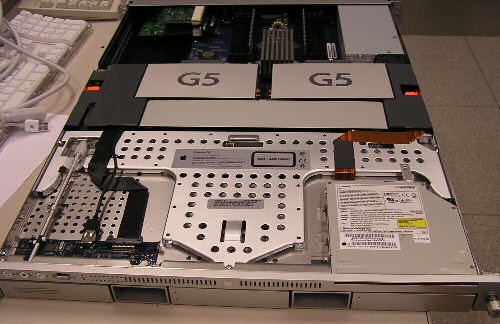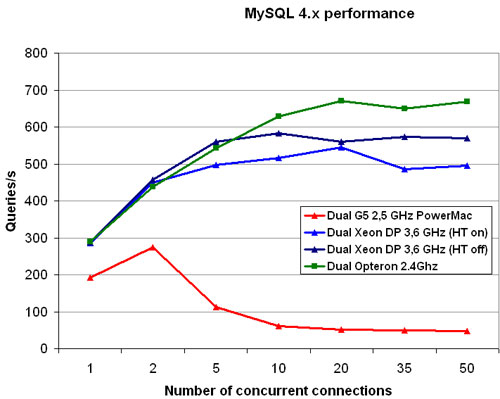No more mysteries: Apple's G5 versus x86, Mac OS X versus Linux
by Johan De Gelas on June 3, 2005 7:48 AM EST- Posted in
- Mac
The G5 as Server CPU
While it is the Xserve and not the PowerMac that is Apple's server platform, we could not resist the temptation to test the G5 based machine as a server too. Installed on the machine was the server version of Mac OS X Tiger. So in fact, we are giving the Apple platform a small advantage: the 2.5 GHz CPUs are a bit faster than the 2.3 GHz of the Xserve, and the RAM doesn't use ECC as in the Xserve.


| Dual G5 2,5 GHz PowerMac | Dual Xeon DP 3,6 GHz (HT on) | Dual Xeon DP 3,6 GHz (HT out) | Dual Opteron 2.4Ghz | |
| 1 | 192 | 286 | 287 | 290 |
| 2 | 274 | 450 | 457 | 438 |
| 5 | 113 | 497 | 559 | 543 |
| 10 | 62 | 517 | 583 | 629 |
| 20 | 50 | 545 | 561 | 670 |
| 35 | 50 | 486 | 573 | 650 |
| 50 | 47 | 495 | 570 | 669 |
Performance is at that point only 1/10th of the Opteron and Xeon. We have tested this on Panther (10.3) and on Tiger (10.4.1), triple-checked every possible error and the result remains the same: something is terribly wrong with the MySQL server performance.
SPEC CPU 2000 Int numbers compiled with GCC show that the G5 reaches about 75% of the integer performance of an equally clocked Opteron. So, the purely integer performance is not the issue. The Opteron should be quite faster, but not 10 times faster.
We checked with the activity monitor, and the CPUs were indeed working hard: up to 185% CPU load on the MySQL process. Notice that the MySQL process consists of no less than 60 threads.

| Concurrency | Dual Powermac G5 2.5 GHz (Panther) | Dual Powermac G5 2.7 GHz (Tiger) | Dual Xeon 3.6 GHz |
| 5 | 216.34 | 217.6 | 3776.44 |
| 20 | 216.24 | 217.68 | 3711.4 |
| 50 | 269.38 | 218.32 | 3624.63 |
| 100 | 249.51 | 217.69 | 3768.89 |
| 150 | 268.59 | 256.89 | 3600.1 |
The new OS, Tiger doesn't help: the 2.7 GHz (10.4.1) is as fast as the 2.5 GHz on Panther (10.3). More importantly, Apache shows exactly the same picture as MySQL: performance is 10 times more worse than on the Xeon (and Opteron) on Linux. Apple is very proud about the Mac OS X Unix roots, but it seems that the typical Unix/Linux software isn't too fond of Apple. Let us find out what happened!










116 Comments
View All Comments
Icehawk - Friday, June 3, 2005 - link
Interesting stuff. I'd like to see more data too. Mmm Solaris.Unfortunately the diagrams weren't labeled for the most part (in terms of "higher is better") making it difficult to determine the results.
And the whole not displaying on FF properly... come on.
NetMavrik - Friday, June 3, 2005 - link
You can say that again! NT shares a whole lot more than just similarites to VMS. There are entire structures that are copied straight from VMS. I think most people have forgotten or never knew what "NT" stood for anyway. Take VMS, increment each letter by one, and you get WNT! New Technology my a$$.Guspaz - Friday, June 3, 2005 - link
Good article. But I'd like to see it re-done with the optimal compiler per-platform, and I'd like to see PowerPC Linux used to confirm that OSX is the cause of the slow MySQL performance.melgross - Friday, June 3, 2005 - link
I was just thinking back about this and remembered something I've seenComputerworld has had articles over the past two years or so about companies who have gone to XServes. They are using them with Apache, SYbase or Oracle. I don't remember any complaints about performance.
Also Oracle itself went to XServes for its own datacenter. Do you think they would have done that if performance was bad? They even stated that the performance was very good.
Something here seems screwed up.
brownba - Friday, June 3, 2005 - link
johan, i always appreciate your articles.you've been /.'d !!!!
and anandtech is holding up well.
good job
bostrov - Friday, June 3, 2005 - link
Since so much effort went in to vector facilities and instruction sets ever since the P54 days, shouldn't "best effort" on each CPU be used (use the IBM compiler on G5 and the Intel compiler on x86) - by using gcc you're using an almost artifically bad compiler and there is no guarantee that gcc will provide equivilant optimizations for each platform anyway.I think it'd be very interesting to see an article with the very best available compilers on each platform running the benchmarks.
Incidently, intel C with the vector instruction sets disabled still does better.
JohanAnandtech - Friday, June 3, 2005 - link
bostrov: because the Intel compiler is superb at vectorizing code. I am testing x87 FPU and gcc, you are testing SSE-2 performance with the Intel compiler.JohanAnandtech - Friday, June 3, 2005 - link
minsctdp: A typo which happened during final proofread. All my original tables say 990 MB/s. Fixed now.bostrov - Friday, June 3, 2005 - link
My own results for flops 2.0: (compiled with Intel C 8.1, 3.2 Ghz Prescott with 160 Mhz - 5:4 ratio - FSB)flops20-c_prescott.exe
FLOPS C Program (Double Precision), V2.0 18 Dec 1992
Module Error RunTime MFLOPS
(usec)
1 1.7764e-013 0.0109 1288.7451
2 -1.4166e-013 0.0082 852.7242
3 8.1046e-015 0.0067 2531.7045
4 9.0483e-014 0.0052 2858.2062
5 -6.2061e-014 0.0140 2065.6650
6 3.3640e-014 0.0100 2906.2439
7 -5.7980e-012 0.0327 366.4559
8 3.7692e-014 0.0111 2700.8968
Iterations = 512000000
NullTime (usec) = 0.0000
MFLOPS(1) = 1088.7826
MFLOPS(2) = 854.7579
MFLOPS(3) = 1609.7508
MFLOPS(4) = 2753.5016
Why are the anandtech results so poor?
melgross - Friday, June 3, 2005 - link
I thought that GCC comes with Tiger. I have read Apple's own info, and it definitely mentions GCC 4. Perhaps that would help the vectorization process.Altivec is such an important part of the processor and the performance of the machine that I would like to see properly written code used to compare these machines.